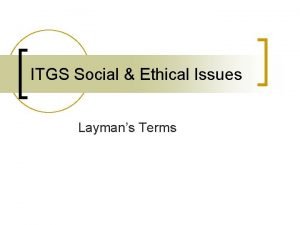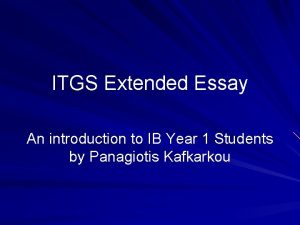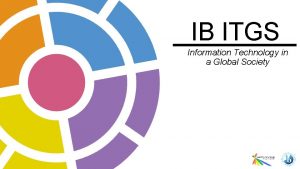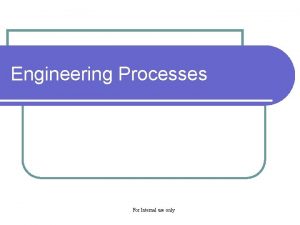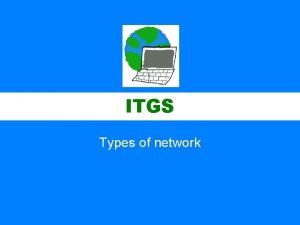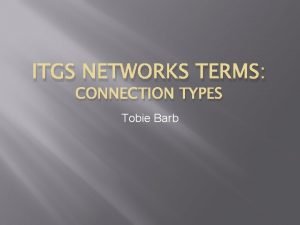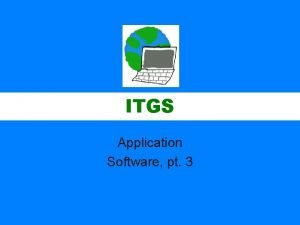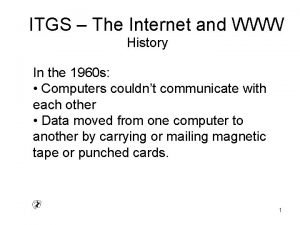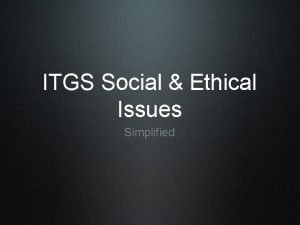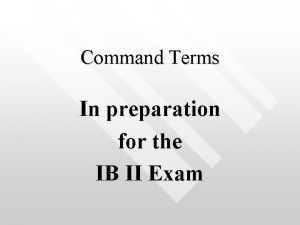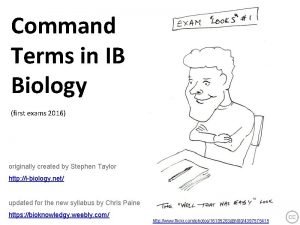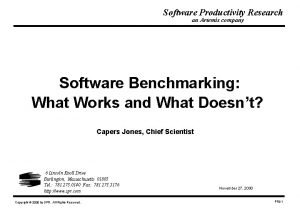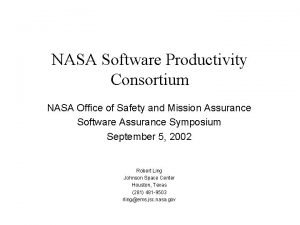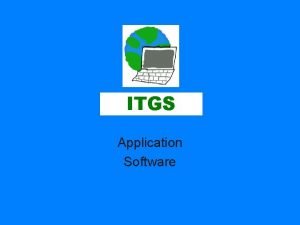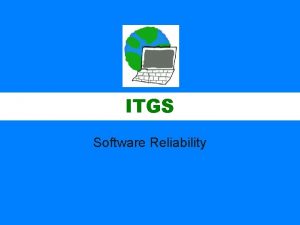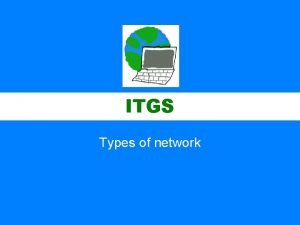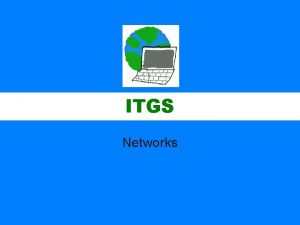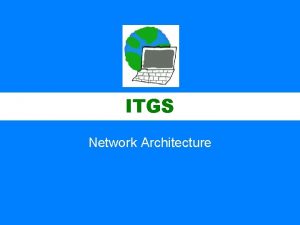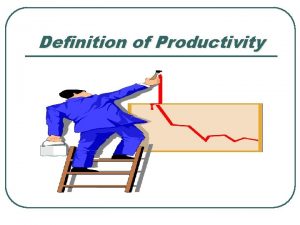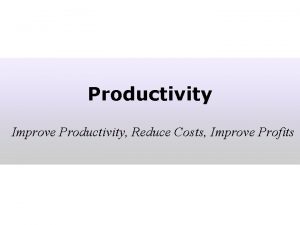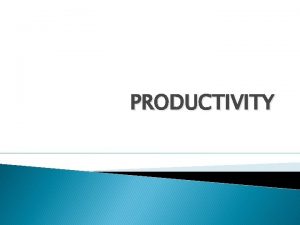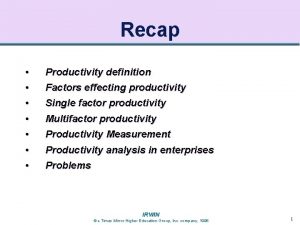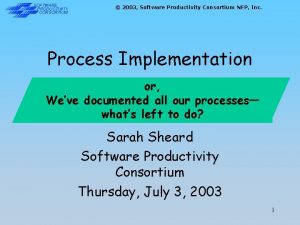ITGS Application Software ITGS Application software productivity software














- Slides: 14

ITGS Application Software

ITGS • Application software (productivity software) – Allows the user to perform tasks to solve problems, such as creating documents, managing finances, or editing images.

ITGS • Word processing software – Allows the creation of typed documents such as letters, memos, and business proposals • Features are optimized for text creation, including formatting, spelling check and language tools – Mail merge - a common tool which allows a single template document to be customized for individual people

ITGS • Desktop Publishing (DTP) software (page layout software) – Allows the creation of documents such as leaflets, brochures, posters, newsletters, and magazines – DTP allows much greater control over the page layout than a word processor, and can prepare documents for output on professional commercial printers

ITGS • Desktop Publishing (DTP) software – allows complex pages of text and graphics to be laid out for publications • Word processing software and DTP software both WYSIWYG (what you see is what you get) – the appearance of the document on the screen is exactly how it will appear when printed • Word processing software is focused more on the line-by -line creation of text documents • DTP software is page-oriented, allowing objects such as text frames, images and tables to be placed anywhere on the page

ITGS • Desktop Publishing (DTP) features – Master pages - when features are added to a master page, they are automatically added to every page in the document • Useful for page numbers, headers and footers – Templates - provide predefined layouts for creating a variety of document types • Users replace the supplied dummy text and images with their own – Grouping tools • Allow you to manage multiple objects at the same time – Alignment options • Allow objects to be positioned with precision

ITGS • Desktop Publishing (DTP) features – DTP also offers more advanced text management features than word processors • The ability to adjust typography features such as: – Kerning / tracking - adjusting the spaces between individual letters – Ligatures - combining two letters together to make one character, such as “fl” – DTP users often require output which can be professionally printed • Most DTP software supports exporting in standard file formats such as PDF • Includes color management options and colour separations – Before exporting for print, pre-flight checks can be done to scan the document for printing problems such as images with insufficient resolution

ITGS • TIPS FOR SUCCESSFUL DTP • Use a consistent layout - similar styles, themes and colors should apply to all or most pages in a publication • Use only a few fonts - one for text and one for headings • Break up long lines into columns to reduce line length • Dark colors are heavy and should be used sparingly and balanced • Use white space • Images for professional printing should be at least 300 dpi • Resize images in image editing software, not DTP

ITGS • Adobe PDF – Portable Document Format - used for distributing digital documents • PDFs can include embedded fonts so that documents appear exactly the same on every computer • PDF viewers are freely available, so the recipient doesn’t need the same DTP software as the document creator – Different monitors, printers, scanners and cameras all represent colors with different levels of intensity and brightness due to differences in their design • Color synchronization or color management – Ensuring colors produced by the otuput device match the colors chosen by the designer in software • ICC Color Profiles – Help achieve consistent colors, regardless of output medium, by describing how individual devices process colors » Color space - describes how colors are defined (RGB, CMYK)

ITGS • Presentation software – Focuses on the creation of slides for giving verbal presentations • Spreadsheet software – Used to perform tasks involving lots of calculations, such as managing finances or student grades • Spreadsheets divide a worksheet into a grid of cells labelled with letters and numbers – Individual cell references are used in formulae to calculate values in other cells – Spreadsheets support automatic recalculation - if the value in one cell changes, any other cells referring to that cell will update to reflect the change

ITGS • Database software – Used to create, store, structure and sort a collection of data about a set of items, search for certain data using queries, and produce printed reports • Can be complex Relational Database Management Systems to manage data about millions of items (Amazon and Facebook use these)

ITGS • Web Browser – Software used to view webpages • Web development software – Used to create and design websites • Includes a code editor which allows users to enter HTML, CSS and Javascript code • More advanced programs like Dreamweaver include a graphical editor allowing pages to be created without knowledge of HTML • Also lets users check their websites for compatibility wth different web browsers

ITGS • Graphics software – Used to create or edit digital images • Basic - creation of images by drawing individual pixels and shapes • More advanced - powerful effects to manipulate images – Vector graphics - focuses on the creation of images using mathematical shapes – 3 D rendering software - allows the creation of 3 D objects which can be given color, texture, and lighting, and rendered to produce a final images which is hard to distinguish from a photograph – Computer Aided Design (CAD) » Focuses on product design, using 3 D graphics to represent components and allowing designers to create prototypes within the computer

ITGS • Audio software – Used to record, edit and mix digital audio • Multiple tracks or sound can be recorded and combined, and various effects and fades can be applied – Heavily used in music, film and television industries • Video editing software – Allows images, sound and video to be combined
